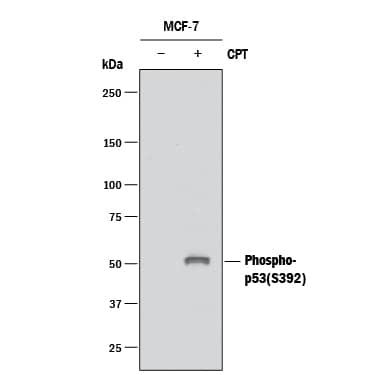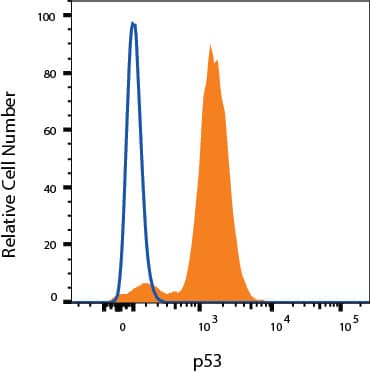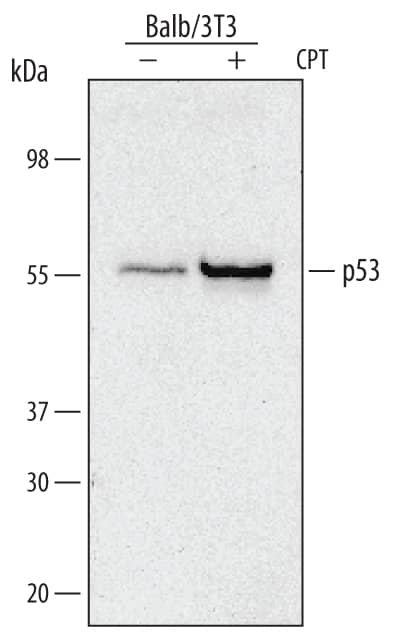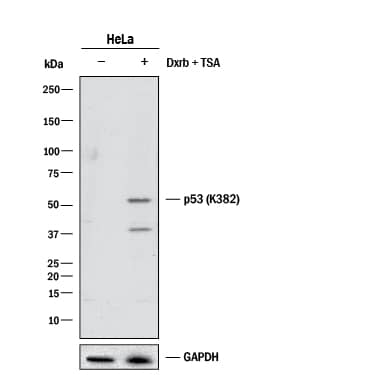p53 Products
p53 is well known for its key role as a tumor suppressor protein. It is 393 amino acids (aa) in length with a predicted molecular weight of 44 kDa. It belongs to the p53 family that also includes p63 and p73. Structurally, p53 is characterized by an N-terminal transactivation domain, central DNA-binding and oligomerization domains, and a C-terminal regulatory domain. It is thought to exist as a homotetramer, and it exhibits approximately 72% and 76% aa identity with its mouse and rat orthologs, respectively. Mutations in the p53 gene are one of the most frequent genomic events accompanying oncogenic transformation. p53 responds to signals such as DNA damage or cell stress primarily through its actions as a transcription factor. Among its gene targets are a range factors that promote DNA repair mechanisms or apoptosis including cell cycle regulatory proteins and members the Bcl-2 family. Because of its critical role in genomic homeostasis, p53 activities are tightly regulated by a network of protein-protein interactions, microRNAs, and a range of post-translational modifications, including phosphorylation, acetylation, methylation, and ubiquitination. A widely studied regulator is Murine Double Minute 2 (MDM2). MDM2 is known to suppress p53 activity through direct binding or through its actions as a Ubiquitin ligase (E3) that catalyzes p53 ubiquitination and proteasome-mediated degradation.
1130 results for "p53" in Products
1130 results for "p53" in Products
p53 Products
p53 is well known for its key role as a tumor suppressor protein. It is 393 amino acids (aa) in length with a predicted molecular weight of 44 kDa. It belongs to the p53 family that also includes p63 and p73. Structurally, p53 is characterized by an N-terminal transactivation domain, central DNA-binding and oligomerization domains, and a C-terminal regulatory domain. It is thought to exist as a homotetramer, and it exhibits approximately 72% and 76% aa identity with its mouse and rat orthologs, respectively. Mutations in the p53 gene are one of the most frequent genomic events accompanying oncogenic transformation. p53 responds to signals such as DNA damage or cell stress primarily through its actions as a transcription factor. Among its gene targets are a range factors that promote DNA repair mechanisms or apoptosis including cell cycle regulatory proteins and members the Bcl-2 family. Because of its critical role in genomic homeostasis, p53 activities are tightly regulated by a network of protein-protein interactions, microRNAs, and a range of post-translational modifications, including phosphorylation, acetylation, methylation, and ubiquitination. A widely studied regulator is Murine Double Minute 2 (MDM2). MDM2 is known to suppress p53 activity through direct binding or through its actions as a Ubiquitin ligase (E3) that catalyzes p53 ubiquitination and proteasome-mediated degradation.
| Reactivity: | Human, Mouse, Rat, Yeast, Xenopus (Negative) |
| Details: | Mouse IgG1 kappa Monoclonal Clone #PAb 240 |
| Applications: | IHC, WB, ELISA, ICC/IF, Flow, +2 More |
| Reactivity: | Human, Mouse, Rat |
| Details: | Goat IgG Polyclonal |
| Applications: | WB, Simple Western, IP, ChIP, ICC, +1 More |
| Reactivity: | Human |
| Details: | Rabbit IgG Polyclonal |
| Applications: | WB, IHC, IP, ICC |
| Reactivity: | Human |
| Details: | Rabbit IgG Polyclonal |
| Applications: | IHC, WB, Flow, IP, ChIP, +1 More |
| Reactivity: | Human, Mouse, Rat, Yeast, Xenopus (Negative) |
| Details: | Mouse IgG1 kappa Monoclonal Clone #PAb 240 |
| Applications: | IHC, WB, ELISA, ICC/IF, Flow, +2 More |
| Reactivity: | Human, Mouse, Rat |
| Details: | Mouse IgG2b Monoclonal Clone #184721 |
| Applications: | WB, IP, ICC |
| Reactivity: | Human, Mouse, Rat |
| Details: | Goat IgG Polyclonal |
| Applications: | WB |
| Assay Range: | 125 - 8,000 pg/mL |
| Applications: | ELISA |
| Reactivity: | Human |
| Details: | Rabbit IgG Monoclonal Clone #2185A |
| Applications: | WB, ICC |
| Reactivity: | Human, Mouse, Monkey, Rabbit |
| Details: | Mouse IgG1 Monoclonal Clone #OTI5E2 |
| Applications: | IHC, WB, ICC/IF, Flow, Simple Western |
| Assay Range: | 312 - 20,000 pg/mL |
| Applications: | ELISA |
| Reactivity: | Human, Monkey, Bovine |
| Details: | Mouse IgG2a Kappa/IgG2b Kappa Monoclonal Clone #BP53-12 + DO-7 |
| Applications: | IHC, WB, ICC/IF, Flow, CyTOF-ready |
Recombinant Monoclonal Antibody.
| Reactivity: | Human |
| Details: | Rabbit IgG Monoclonal Clone #TP53/1799R |
| Applications: | IHC, WB, ICC/IF, Flow, MA |
| Reactivity: | Human |
| Details: | Rabbit IgG Polyclonal |
| Applications: | WB, Simple Western, IHC |
| Reactivity: | Human |
| Details: | Mouse IgG1 Monoclonal Clone #CL2199 |
| Applications: | IHC, WB, ICC/IF, Mycoplasma, Simple Western, +1 More |
Recombinant Monoclonal Antibody.
| Reactivity: | Human, Mouse, Rat, Monkey, Rabbit |
| Details: | Rabbit IgG Kappa Monoclonal Clone #PAb421 |
| Applications: | IHC, WB, ELISA, ICC/IF, Flow, +2 More |
| Reactivity: | Human, Mouse |
| Details: | Rabbit IgG Polyclonal |
| Applications: | IHC, WB, ICC/IF, IP |
| Reactivity: | Human, Mouse, Monkey |
| Details: | Mouse IgG1 Monoclonal Clone #OTI5E2 |
| Applications: | IHC, WB, ICC/IF, Flow, CyTOF-ready, +1 More |
| Reactivity: | Human |
| Details: | Mouse IgG2b Monoclonal Clone #184727 |
| Applications: | CyTOF-ready, ICFlow |
| Reactivity: | Mouse |
| Details: | Rat IgG2b Monoclonal Clone #197643 |
| Applications: | IP |
| Reactivity: | Human, Mouse, Rat |
| Details: | Goat IgG Polyclonal |
| Applications: | WB |
Recombinant Monoclonal Antibody.
| Reactivity: | Human |
| Details: | Rabbit IgG Monoclonal Clone #2589A |
| Applications: | WB, IHC, ICC |
Recombinant Monoclonal Antibody.
| Reactivity: | Human |
| Details: | Rabbit IgG Monoclonal Clone #TP53/1799R |
| Applications: | IHC, WB, ICC/IF, Flow, CyTOF-ready, +1 More |
| Reactivity: | Human |
| Details: | Rabbit IgG Polyclonal |
| Applications: | WB, IHC |
| Reactivity: | Human, Monkey, Bovine |
| Details: | Mouse IgG2b Kappa Monoclonal Clone #DO-7 |
| Applications: | IHC, WB, Simple Western |

![Western Blot: p53 Antibody (PAb 240)BSA Free [NB200-103] Western Blot: p53 Antibody (PAb 240)BSA Free [NB200-103]](https://resources.bio-techne.com/images/products/p53-Antibody-PAb-240-Western-Blot-NB200-103-img0001.jpg)



![Western Blot: p53 Antibody [NB200-171] Western Blot: p53 Antibody [NB200-171]](https://resources.bio-techne.com/images/products/p53-Antibody-Western-Blot-NB200-171-img0076.jpg)
![Western Blot: p53 Antibody (PAb 240)Azide and BSA Free [NBP2-80898] Western Blot: p53 Antibody (PAb 240)Azide and BSA Free [NBP2-80898]](https://resources.bio-techne.com/images/products/p53-Antibody-PAb-240-Azide-and-BSA-Free-Western-Blot-NBP2-80898-img0001.jpg)




![Western Blot: p53 Antibody (OTI5E2) [NBP2-00723] Western Blot: p53 Antibody (OTI5E2) [NBP2-00723]](https://resources.bio-techne.com/images/products/p53-Antibody-5E2-Western-Blot-NBP2-00723-img0018.jpg)

![Immunohistochemistry-Paraffin: p53 Antibody (BP53-12 + DO-7) - Azide and BSA Free [NBP2-34563] Immunohistochemistry-Paraffin: p53 Antibody (BP53-12 + DO-7) - Azide and BSA Free [NBP2-34563]](https://resources.bio-techne.com/images/products/p53-Antibody-BP53-12-+-DO-7-Azide-and-BSA-Free-Immunohistochemistry-Paraffin-NBP2-34563-img0001.jpg)
![Western Blot: p53 Antibody (TP53/1799R) [NBP2-59631] Western Blot: p53 Antibody (TP53/1799R) [NBP2-59631]](https://resources.bio-techne.com/images/products/p53-Antibody-TP53-1799R-Western-Blot-NBP2-59631-img0005.jpg)

![Immunohistochemistry-Paraffin: p53 Antibody (CL2199) [NBP2-34495] Immunohistochemistry-Paraffin: p53 Antibody (CL2199) [NBP2-34495]](https://resources.bio-techne.com/images/products/p53-Antibody-CL2199-Immunohistochemistry-Paraffin-NBP2-34495-img0021.jpg)
![Western Blot: p53 Antibody (PAb421)ChimericAzide and BSA Free [NBP2-62555] Western Blot: p53 Antibody (PAb421)ChimericAzide and BSA Free [NBP2-62555]](https://resources.bio-techne.com/images/products/p53-Antibody-PAb421-Chimeric-Western-Blot-NBP2-62555-img0003.jpg)
![p53 antibody [N1], N-term detects p53 protein at nucleus by immunofluorescent analysis.<br></br>Samples: HCT 116 cells mock (left) and treated with 30 uM Cisplatin for 24 hrs (right) were fixed in 4% paraformaldehyde at RT for 15 min.<br>Green: p53 protein stained by p53 antibody [N1], N-term.<br>Blue: Hoechst 33342 staining.<br>Scale bar = 10 um.](https://resources.bio-techne.com/images/products/p53-Antibody-Western-Blot-NBP2-19667-img0006.jpg)
![Western Blot: p53 Antibody (OTI5E2)Azide and BSA Free [NBP2-73200] Western Blot: p53 Antibody (OTI5E2)Azide and BSA Free [NBP2-73200]](https://resources.bio-techne.com/images/products/p53-Antibody-OTI5E2-Azide-and-BSA-Free-Western-Blot-NBP2-73200-img0002.jpg)



![Western Blot: p53 Antibody (TP53/1799R)Azide and BSA Free [NBP2-59632] Western Blot: p53 Antibody (TP53/1799R)Azide and BSA Free [NBP2-59632]](https://resources.bio-techne.com/images/products/p53-Antibody-TP53-1799R-Azide-and-BSA-Free-Western-Blot-NBP2-59632-img0004.jpg)
![Western Blot: p53 Antibody (DO-7) [NBP2-34308] Western Blot: p53 Antibody (DO-7) [NBP2-34308]](https://resources.bio-techne.com/images/products/p53-Antibody-DO-7-Western-Blot-NBP2-34308-img0004.jpg)